PinotFile: 11.47 July 7, 2019
|
Extensive Tasting of 2016 & 2017 Vintage Willamette Valley Pinot Noir
In 2017, winter rain gave needed relief to years of drought. The growing season that followed was cool and wet compared to the past few years. Bud break started closer to normal in mid-April. Record heat followed in late May that initiated flowering, then the weather cooled in early June, with a few days of record high temperatures returning for a few days later in June. The warm conditions in 2016 created increased fruitiness and resulted in larger clusters and more clusters per vine. The heat ramped up in July and August with heat stress events both early and late in the month. August was the warmest August on record in Oregon. Fires and smoke were an issue in Southern Oregon and in the Columbia Gorge but the Willamette Valley was spared. A cooling weather pattern in mid-September led to a slow and steady harvest. Growers reported near average to slightly higher than average sugar and acid levels but generally balanced fruit. The result in 2017 was both a solid vintage and abundant quantity.
Argyle Winery, DundeeArgyle has played a pivotal role in establishing Willamette Valley as one of the best places in the world to make sparkling wine. It is one of the only American wineries with an Extended Tirage program going back decades. Few wineries allow their wines to benefit from extended aging due to the significant expense involved. The Argyle estate program includes more than 400 acres of vines spread across four estate properties. The winemaker, Nate Klostermann, spent eight years being mentored by pioneering vintner Rollin Soles before being named his successor at Argyle in 2013. Visit www.argylewinery.com.
2008 Argyle Extended Tirage Brut Willamette Valley Sparkling Wine 12.5% alc.,1300 cases, $80. Harvest Brix 19.6º. 63% Pinot Noir, 37% Chardonnay. Bottle fermented. Aged on the lees for 10 years before disgorgement (disgorged July 2018) in 25% neutral barrel and 75% stainless steel. 25% MLF. Dosage 4 g/L. · Light white peach color in the glass. The nose is more savory and less fruity than the 2015 vintage offering aromas of roasted nuts, warm brioche, and yellow plum. Complex on the palate, with flavors of citrus, green apple gripping and saturating the palate. Plenty of energy, crispness and minerality, literally taking the breath away on the extended finish. Score: 95
2015 Argyle Vintage Brut Willamette Valley Sparkling Wine 12.5% alc., $28. A portion of this wine will be held back for extended aging and will become the Extended Tirage Brut. 70% Pinot Noir, 20% Chardonnay and 10% Pinot Meunier. Harvest Brix 19.2º. Aged in 93% stainless steel and 7% neutral oak. Dosage 6 g/L. · Light white peach color in the glass. Very enticing, clean aromas of apricot, grilled lemon, pastry creme, yeast and roasted nuts. Vibrant flavors of white peach and Rainer cherry. Slightly creamy with a hint of tannin on the knife-edged finish. Score: 92
2017 Argyle Willamette Valley Pinot Noir 13.8% alc., $27, screw cap. Made from 100% estate grapes, with 50% of the fruit from Lone Star Vineyard and 50% from Knudsen Vineyard and Spirit Hill Vineyard. Harvest Brix 23.0º. Fermented in 1.5-ton lots with hand punch downs. · Light ruby red color in the glass. Aromas of red cherry, red cranberry and baking spices. Light to mid weight in extraction and red fruited in character, with a modest oak underbelly. Easy drinking, with silky tannins and a slightly astringent finish. Score: 88
Big Table Farm, Gaston
2017 Big Table Farm Willamette Valley Pinot Noir 13.5% alc., 2,509 cases, $45. Released March 4, 2019. All Northern Willamette Valley vineyards that winemaker Brian Marcy works with are included in this blend. More affordable because more of it is made, but it gets the same care and handling as the rest of the wines. Unfined and unfiltered. · Moderately light garnet color in the glass. A complex nose reflects whole cluster fermentation, with aromas of dark berries, fertile earth, burnt tobacco, rose petal, herbs and exotic spices. A wine with character, offering flavors of dark red cherries and berries, earth and mushroom. Sleek, with healthy tannins and good energy. Better when tasted the following day from a previously opened bottle, although the whole cluster tannins may require a few years to fully resolve. Score: 91
2017 Big Table Farm Pelos Sandberg Vineyard Eola-Amity Hills Willamette Valley Pinot Noir 13.5% alc., 241 cases, $62. Released March 4, 2019. Unfined and unfiltered. · Moderate garnet color in the glass. Nicely perfumed with aromas of black cherry, fertile earth, dried herbs and pipe smoke. Filled with succulent cherry and berry fruits and accented with a note of creosote and tobacco typical of this vineyard. Currently, the lavish tannins show up as some astringency on the finish. An intriguing wine with an extended finish. Unchanged when sampled from a previously opened bottle the following day. Score: 92
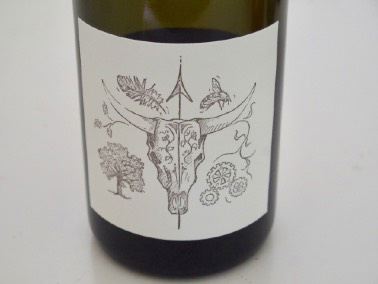 2017 Big Table Farm Earth Willamette Valley Pinot Noir 13.8% alc., 104 cases, $105, $240 magnum. Released April 15, 2019. 4 barrels that are the best of the vintage. Unfined and unfiltered. · Moderate garnet color in the glass. Lively and captivating aromas of black cherry, spice, fertile soil and pipe smoke. Delicious mid weight flavors of blueberry, black cherry, black raspberry, spice and burnt tobacco. Discretely concentrated with a noticeable mid palate impression and finish. Silky in texture, with felty, fine-grain tannins on the backend. Excellent balance and sure to go the distance. Spice up your life with this beauty. Score: 95
Chehalem Winery, NewbergWines are produced from three estate vineyards that include Stoller Vineyard in the Dundee Hills AVA (volcanic soil), Ridgecrest Vineyard in the Ribbon Ridge AVA (sandstone and siltstone soil), and Corral Creek Vineyard in the Chehalem Mountains AVA (Laurelwood soil). The winemaker is Katie Santora who joined Chehalem in 2012 as assistant winemaker and became the winemaker in 2018.
2018 Chehalem Chehalem Mountains Pinot Noir Rosé 13.2% alc., pH 3.16, TA 0.67, $25, screw cap. · Light pink color in the glass. Very shy aromas of orange peel and rose petal. Light in weight, featuring demure flavors of red berry and yellow peach. Pleasant and nicely balanced, but so austere it is not eye-catching. Score: 88
2017 Chehalem Chehalem Mountains Pinot Noir 13.5% alc., pH 3.41, TA 0.58, $N/A, screw cap. · Light garnet color in the glass. Pleasant aroma of cherry gum drop. A straightforward, amicable wine with flavors of oak-kissed dark red cherry and purple berry framed by modest tannins, finishing modestly with a sweet cherry tone. Score: 88
Coeur de Terre, McMinnvilleProprietor and winemaker Scott Neal has really his stride with the 2015 and 2016 vintage Pinot Noirs. I now consider this winery to be among the top echelon of estate grown and produced Pinot Noir in Oregon. The estate vineyard has been organically farmed since its inception in 1998. Visit www.cdtvineyard.com.
2016 Coeur de Terre Oregon Pinot Noir 13.8% alc., 2,168 cases, $22. 60% of fruit from the Estate Vineyard combined with fruit from other vineyards in the McMinnville AVA and one vineyard that borders the AVA. · Moderately light garnet color in the glass. Effusive aromas of dark cherry, raspberry and rhubarb please the nose and reach more intensity over time in the glass. Oak-kissed black cherry core in an easygoing, forward-drinking style that has enviable balance and an energetic, juicy finish. A great value in a wine that would make the perfect companion to everyday meals. Score: 91
2016 Coeur de Terre Héritage Reserve Estate McMinnville Willamette Valley Pinot Noir 13.8% alc., 303 cases, $38. This wine is meant to capture the expression of the oldest vines on the estate vineyard. It is a barrel selection of all four blocks. Yield 1.86 tons per acre. · Moderately dark garnet color in the glass. Brooding aromas of black fruits, fertile earth and botanical input. An array of purple and black fruits are beautifully balanced by benevolent tannins and acidity. There is an underlying savory vegetal thread. Nothing earth shaking here, but a very solid and satisfying effort. Score: 92
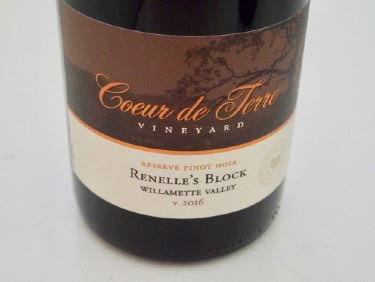 2016 Coeur de Terre Renelle’s Block Reserve McMinnville Willamette Valley Pinot Noir 13.8% alc., 69 cases, $65. Willakenzie sedimentary soils. The oldest block on Coeur de Terre Vineyard planted in the spring of 1999. · Moderately dark garnet color in the glass. Expressive aromas of blackberry, cassis, and vanilla. Notably graceful and polished with a discretely concentrated core of blackberry and pomegranate fruit flavors. The exquisite balance and extremely long finish make this wine stand out among all the 2016 Block offerings. Score: 94
2016 Coeur de Terre Sarah Jane’s Block Reserve McMinnville Willamette Valley Pinot Noir 13.7% alc., 68 cases, $65. Willakenzie soils. A mixture of six clones planted in 2000. · Moderately dark garnet color in the glass. Aromas of plum, black cherry and pomegranate are reflected in the flavors of this voluptuous wine that is infused with dominating tannins. Still, the wine has good juiciness and a gloriously intense finish. Score: 92
2016 Coeur de Terre Tallulah’s Run Reserve McMinnville Willamette Valley Pinot Noir 13.7% alc., 68 cases, $65. Dijon 115, 667 and 777. Both volcanic and sedimentary soils. This block was planted in 2004 with 1778 vines per acre. · Moderately dark garnet color in the glass. Generous aromas of spiced blackberry and friendly oak lead to a middleweight-styled wine with earth enhanced fruit flavors of black cherry and blackberry. Silken and seductive in texture, with fine-grain tannins and a persistent, sweet, blackberry-infused finish. Score: 93
Evesham Wood, SalemThis iconic Willamette Valley winery consistently offers superb estate grown Pinot Noir as well as vineyarddesignated Pinot Noirs from highly regarded vineyards nearby. The wines represent excellent values considering the high quality. The wines are all made from sustainably grown grapes from non-irrigated properties. The estate Le Puits Sec Vineyard is certified organic by OTCO. The 2016 wines reviewed here are somewhat backward, very concentrated and somewhat tannic and should be decanted if enjoyed currently. Better yet, cellar them a few years and you will be rewarded. Visit www.eveshamwood.com.
2017 Evesham Wood Willamette Valley Pinot Noir 13.0% alc., $22. · Light garnet color in the glass. Slightly reduced upon opening, offering aromas of cherry, savory dried herbs and underbrush. Light to mid weight in style and quite savory in character, featuring oak-kissed red and black fruit flavors with an underpinning of dried herbs. Soft and congenial in the mouth, with modest tannins, juicy acidity and an unpretentious finish. More giving and fruity when tasted the following day from a previously opened bottle. Score: 89
2016 Evesham Wood Le Puits Sec Eola-Amity Hills Willamette Valley Pinot Noir 13.0% alc., $40. · Moderately dark garnet color in the glass. Purple fruits, floral goodness and a hint of oak combine to produce a pleasing nose. A charming wine offering well-spiced fruit flavors of black cherry and purple berry and complimentary oak. The wine was considerably more enjoyable when tasted a day after opening when the initial slightly astringent finish had smoothed out completely. Score: 92
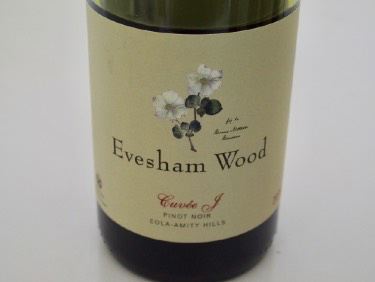 2016 Evesham Wood Cuvée J Eola-Amity Hills Willamette Valley Pinot Noir 13.0% alc., $50. · Moderately dark garnet color in the glass. The nose is oak-laden upon opening, but more fruity and enticing when the wine was tasted the following day from a previously opened bottle. Waves of black raspberry and Marionberry fruit flavors greet the mid palate. A healthy tannic backbone balances the fruit load. The wine has the longest finish by far of any of the 2016 Evesham Pinot Noir wines.Considerably better when tasted the following day from a previously opened bottle when the tannins and oak treatment had mellowed and the wine’s awkwardness had resolved. Be patient and you will be rewarded! Score: 94
2016 Evesham Wood Temperance Hill Vineyard Eola-Amity Hills Willamette Valley Pinot Noir 13.0% alc., $36. Made from certified organic grapes. · Dark garnet color in the glass. Aromas of purple fruits, woodshed and blood initially, becoming more fruit driven over time in the glass. Fullbodied and a bit rugged as is typical of this vineyard, displaying an array of purple and black fruits backed by substantial tannins. A big wine with gorgeous fruit that is reticent upon opening. When tasted the following day from a previously opened bottle, the wine was more open and giving, with some mellowing of tannins. Score: 92
2016 Evesham Wood Sojourner Vineyard Eola-Amity Hills Willamette Valley Pinot Noir 13.0% alc., $36. · Moderately dark garnet color in the glass. Aromas of cherry tart, peppery herbs and vanilla. Mid weight flavors of black cherry and purple berry with a welcome touch of spice. Satiny in texture with reserved tannins, accessible fruit and a persistent, aromatically intense finish. This vineyard has produced several remarkable wines from a notable producers in the past few vintages and is one to focus on when making purchasing decisions. Score: 93
Geødesy, SalemThis new winery, established by Judy Jordan, the former owner of J Vineyards & Winery, offers estate grown wines from Napa Valley and Oregon’s Willamette Valley including Pinot Noir and Chardonnay. Geødesy was founded in gratitude to the agricultural community with the sole purpose of empowering the next generation of young women. All of the winery’s profits support the Wild Goat Edge program, which nourishes young women through connectivity with teachers, mentors and internship sponsors who guide, support, and empower them. Visit www.geodesywine.com.
2017 Geødesy Chehalem Mountain Vineyard Chehalem Mountains Willamette Valley Pinot Noir 14.2% alc., pH 3.45, TA 0.60, 115 cases, $80. Harvest Brix 24.3º. 15% whole cluster. Concrete open-top tank 18-day maceration including a 5-day cold soak. Native MLF and aging 15 months on the lees in French oak barrels, 50% new. Bottled unfined and unfiltered. · Moderately dark garnet color in the glass. Pleasing array of aromas including black raspberry, blackberry, baking spices, dark cocoa, vanilla and toast. Mid weight plus in style with a burly core of deep people and black fruits framed by evident tannins. The finish is long and fruity. This wine has propelled by burly fruit and shows a little less charm than the Eola Springs Vineyard bottling. Score: 91
2017 Geødesy Eola Springs Vineyard Eola-Amity Hills Willamette Valley Pinot Noir 14.2% alc., pH 3.55, TA 0.59, 143 cases, $80. Harvest Brix 24.3º. 5-day cold soak, native yeast and native malolactic fermentation, aged in French oak barrels, 57% new and balance 1-year-old. · Moderate garnet color in the glass. Engaging black cherry aromas rise from the glass. Seamless, refined and polished in a mid weight plus style featuring dark cherry and raspberry flavors with commendable oak integration. Modest tannins, enviable balance, and a persistent, graceful finish. Less concentration but more charm than the Chehalem Mountain Vineyard bottling. Score: 93
Jackalope Wine Cellars, DundeeCorey Schuster, a former civil engineer, began his journey in the wine industry working for a family-owned winery near Salem, Oregon. He found harvest work very gratifying and was hooked. In 2004, he quite his job, acquired a jackalope tattoo on his right shoulder and set out traveling and learning more about wine. In 2012, Jackalope Wine Cellars was launched.The jackalope is a mythical creature of North America that is a cross between a jackrabbit and antelope. Visit www.JackalopeWineCellars.com.
2016 Jackalope Wine Cellars Silvershot Vineyard Eola-Amity Hills Willamette Valley Pinot Noir 13.5% alc., $N/A. Spontaneous fermentation, 10% whole cluster, aged 11 months in French oak barrels. Bottled unfined and unfiltered. · Moderately dark garnet color in the glass. A very savory nose initial with aromas of earthy flora, tobacco, creosote and dark berries. Velvety in the mouth offering mid weight flavors of black raspberry and blueberry with an animale character. When tasted the followed day from a previously opened and re-corked bottle, the wine was less savory and more fruity with a very pleasing finish of uncommon length. Score: 90
2017 Jackalope Wine Cellars Nemarniki Vineyard Chehalem Mountains Willamette Valley Pinot Noir 12.1% alc., $26. Native yeast fermentation, 30% whole cluster, aged 12 months in French oak barrels. Bottled unfined and unfiltered. · Light ruby red color in the glass. Aromas of red cherry, cranberry, raspberry and leaf. Light in weight and red fruited with a hint of spice and green herbs in the background. Smooth in texture, with a lasting red licorice finish. Score: 89
Iris Vineyards, Cottage GroveThis winery offers wines from grapes grown at the estate Chalice Vineyard located in the cool climate of the foothills of the Oregon Coast Range. Visit www.irisvineyards.com.
2016 Iris Vineyards Areté Willamette Valley Pinot Noir 14.1% alc., pH 3.57, TA 0.58, RS 0.1 g/L, 100 cases, $59.99. Released August 2019. A selection of the best barrels from the best blocks of the estate vineyard. Harvest Brix 24.5º. Wädenswil, Pommard, 115 and 113 clones. 100% de-stemmed into 1.25-ton open-top fermenters. Aged in French oak barrels, 25% new. · The nose is primarily oak-driven , even when sampled the following day from a previously opened bottle. There is some nice black cherry and purple berry fruits at the heart of this wine, but the oak treatment overrides the pleasure. The silky texture is quite appealing as is the finish that has some purpose. When tasted the following day, the oak had somewhat integrated indicating this wine would benefit from more time in the cellar but will always be oak infused. Just not my cup of tea. Score: 89
2017 Iris Vineyards Chalice Estate D Block Willamette Valley Pinot Noir 12.7% alc., pH 3.64, TA 0.56, RS <0.1 g/L, 300 cases, $39.99. Released March 2019. Style is intended to be full-bodied, rich, fruit forward and with a strong French oak influence. Harvest Brix 20.8º. Dijon 115. 100% de-stemmed, aged 11 months in French oak barrels, 20% new, 20% once-used. · Moderately light garnet color in the glass. Leading off are aromas of espresso, smoke and red cherry. The mid weight flavors of black cherry and raspberry build in intensity over time in the glass. Bright acidity propels the wine that has balanced tannins and a juicy finish. A thread of smoky oak plies the background. Unchanged when tasted the following day from a previously opened bottle. Score: 88
Keeler Estate Vineyard, AmityWines are produced from an organic and biodynamic vineyard located on a 200-acre property that consists of gardens, forest, lakes, streams and acres of landscaping. Natural winemaking is practiced that includes native yeast fermentation and in addition to stainless steel and French oak barrels, concrete eggs, concrete dolla and terra-cotta amphorae are used. Visit www.keelerestatevineyard.com.
2016 Keeler Eola-Amity Hills Willamette Valley Pinot Noir 13.6% alc., pH 3.53, TA 0.58, 237 cases, $38. Released April 29, 2018. Made with biodynamic grapes. Dijon 943, 667, 115, 777 and Pommard. Harvest Brix 23.8º. Aged 18 months in French oak barrels, 17% new and 83% neutral. After 10 months, 3 neutral barrels of Dijon 115 were moved to a concrete egg vessel to finish for 8 months. · Moderately light garnet color in the glass. The aromas and flavors come more alive over time in the glass. The nose offers scents of cherry, spice and fertile earth with some oak embellishment. A gentle, lighter weighted wine driven by red fruits and companion oak with silky tannins. There is a slight underlying creosote/ash flavor that does not appeal to me. Score: 88
2016 Keeler Craig’s Reserve Eola-Amity Hills Willamette Valley Pinot Noir 13.5% alc., pH 3.53, TA 0.535, 75 cases, $55. Released October 20, 2018. Made with biodynamic grapes. A three barrel blend of Pommard, 115 (30% whole cluster) and 667. Aged 18 months in French oak barrels, 67% 2-year-old and 33% neutral. · Moderately light garnet color in the glass. Nicely appointed aromas of cherry and friendly oak. Very similar to the regular 2016 bottling, but with more extraction and finish. Polished and silky in the mouth, featuring red cherry and berry flavors and a modicum of oak in the background. No creosote note in this wine. Score: 92
Le Cadeau Vineyard, DundeeWinemaker Steve Ryan has an an extensive winemaking background. He was the winemaker at Martinelli in the mid-90s and more recently ran the custom crush facility Rack & Riddle in Healdsburg. He has focused on biodynamic research while making small production wines from California and Oregon, including the Le Cadeau “Côte Est” that he has crafted since 2007. He now resides in the North Willamette Valley and concentrates solely on producing wines from Oregon. The other three wines reviewed here are made by veteran winemaker Jim Sanders whose career dates to the mid 1990s. He has partnered with Le Cadeau proprietor Tom Mortimer to focus on small production Pinot Noir. Visit www.LeCadeauVineyard.com. The wines reviewed here were released March 1, 2019 except for the Merci Reserve that was released October 1, 2018.
2017 Le Cadeau Côte Est Chehalem Mountains Willamette Valley Pinot Noir 13.9% alc., 145 cases, $50. This cuvée combines fruit from a cooler part of the estate vineyard with clones 114, 115 and 667 planted in Nekia (volcanic) soils. Aged 10 months in French oak barrels. · Moderate garnet color in the glass. Lovely aromas of black cherry, raspberry and spice box with an espresso note in the background. Mid weight plus in concentration and bursting with black cherry goodness. Silky in the mouth with gracious tannins and noticeable oak support. Score: 92
2017 Le Cadeau Diversité Chehalem Mountains Willamette Valley Pinot Noir 13.9% alc., 245 cases, $50. Nine clones including Pommard, Mariafeld, Dijon 667, 777, 113, 114, and 115, Mt Eden and Calera planted in the Northern end of the Le Cadeau Vineyard. Aged 11 months in French oak barrels. · Moderately light garnet color in the glass. The nose offers aromas of cherry, fertile earth and oak-driven spice and toast. Suave and silky on the palate, with a mid weight charge of dark cherry fruit framed by a shadow of oak. The gossamer tannins and seductive texture are enticing although the finish is only modest in length. Score: 91
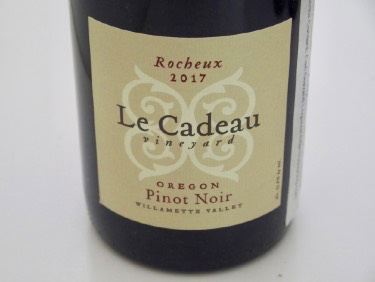 2017 Le Cadeau Rocheux Chehalem Mountains Willamette Valley Pinot Noir 13.9% alc., 174 cases, $50. This cuvée is sourced from the rockiest portion of the estate vineyard, the warmer Western slope. Dijon 777, Pommard and a small amount of Wädenswil. Aged 11 months in French oak barrels. · Moderate garnet color in the glass. Striking aromas of dark red cherry, rose in bloom and subtle oak. Appealing energy and juiciness, featuring mid weight flavors of dusty cherry and raspberry framed by fine-grain tannins. Appealing in many ways, with fine-grain tannins, a little earthiness and textural interest from entry to finish. Score: 93
2016 Le Cadeau Merci Reserve Chehalem Mountains Willamette Valley Pinot Noir 14.1% alc., 124 cases, $80. This wine is composed of estate plantings of heritage clones of Pinot Noir - Mt Eden, Swan and Calera, planted in 2006 and 2008. Aged 14 months in French oak barrels. · Moderately dark garnet color in the glass. Textbook Pinot Noir aromas of black cherry and spicy oak. Mid weight plus in style, offering well-ripened fruit flavors of purple and black berries. A hedonist’s delight, with modest tannins and a big, black-fruited finish. My only nit is the slightest sense of alcoholic warmth. Score: 93
LUMOS Wine Company, McMinnvilleThe LUMOS Pinot Noirs in this vintage feature robust dark fruits and husky tannins and will benefit from decanting or further cellaring. Wines from Temperance Hill Vineyard tend to be this way usually but the character is exaggerated in this vintage.
2018 LUMOS Chiquita Rosé Wren Vineyard Willamette Valley Rosé of Pinot Noir 13.5% alc., 172 cases, $25. Released April 2019. · Moderate pinkish red color in the glass. Pleasant aromas of red berry and cherry. A bolder rosé style, featuring a hardy core of darker red and blue fruit flavors with a savory herb note. The wine veers toward a still Pinot Noir in body and character, lacking the delicacy usually associated with Pinot Noir Rosés. Score: 87
2016 LUMOS Five Blocks Temperance Hill Vineyard Eola-Amity Hills Willamette Valley Pinot Noir 13.5% alc., 143 cases, $25. Released October 2018. · Moderately dark garnet color in the glass. Complex and satisfying nose revealing aromas of black cherry, boysenberry, fertile earth and smoky oak. Velvety in the mouth, with a discrete charge of black cherry and blackberry fruits underlain with a subtle savory thread. Nicely balanced, with integrated tannins, well-managed oak and a modest finish. A solid wine at this price that doesn’t try to do too much. Score: 89
2016 LUMOS Temperance Hill Temperance Hill Vineyard Eola-Amity Hills Willamette Valley Pinot Noir 13.5% alc., 145 cases, $35. Released October 2018. · Moderately dark garnet color in the glass. Blackest cherry and wintergreen aromas show up over time in the glass. Gracious and accessible in a mid weight style infused with an array of black fruits framed by modest tannins. Unchanged when tasted the following day from a previously opened ad re-corked bottle. A basic entry into the Temperance Hills Vineyard. Score: 90
2016 LUMOS North Temperance Hill Vineyard Eola-Amity Hills Willamette Valley Pinot Noir 13.0% alc., 91 cases, $48. Released July 2018. Featured wine at the 2018 International Pinot Noir Festival Grand Seminar. · Moderate garnet color in the glass. This mid weight plus wine offers enticing aromas and flavors of spice, black cherry, boysenberry, dark chocolate and floral goodness with a friendly hint of oak in the background. Silky in texture, with a long, suave finish. Highly enjoyable, with admirable balance. Noticeable better when tasted the following day from a previously opened and re-corked bottle. Score: 93
 2016 LUMOS The G Temperance Hill Vineyard Eola-Amity Hills Willamette Valley Pinot Noir 13.5% alc., 59 cases, $48. Released October 2018. · Dark garnet color in the glass. Brooding, but pleasant aromas of blackberry and black walnut. Sturdy and full-bodied, yet with nice polish and charm, featuring flavors of purple berries. Excellent barrel management, with a compliment of tannins, a soft mouth feel and some finishing generosity. Noticeably better when tasted the following day, exhibiting a big, sweet-fruited finish. Score: 93
2016 LUMOS PumpHouse Temperance Hill Vineyard Eola-Amity Hills Willamette Valley Pinot Noir 13.5% alc., 45 cases, $48. Released October 2018. · Moderately dark garnet color in the glass. Aromas of wine cave, underbrush and rusty iron evolve over time in the glass to reveal purple berry and rose petal aromas. Score: 93
2016 LUMOS Upper Bench Temperance Hill Vineyard Eola-Amity Hills Willamette Valley Pinot Noir 13.5% alc., 67 cases, $48. Released October 2018. · Moderately dark garnet color in the glass. The nose is primarily oak-driven. Full-bodied in style with a sturdy, full and diverse array of black fruit flavors. Gushing with fruit, but lacking in nuance and monotone in character. A modicum of toasty oak adds support. Quite approachable, with modest tannins and some finish. Score: 89
Open Claim Vineyards, GastonThis small winery is located Mt. Pisgah region of the Willamette Valley that is currently pending AVA approval. Both an Open Claim Pinot Noir and Chardonnay are produced from the 55-acre property by noted winemaker Tony Rynders. Both wines are $75 per bottle, and they are sold in $225 three-bottle allocations on the winery’s website at www.openclaimvineyards.com. By the fall of 2019, co-owners Brett and Marnie Wall hope to achieve LIVE (Low Input Viticulture and Enology) certification for their vineyard. The Walls have broken ground on a tasting room that will feature by appointment only chef-inspired pairings beginning in the fall of 2020. The Walls also serve a number of winery clients who have produced vineyard designates including Broadley Vineyards, WildAire Cellars, 00 Wines and Joel Gott Wines.
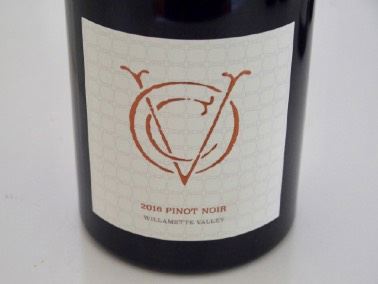 2016 Open Claim Willamette Valley Pinot Noir 14.1% alc., 80 cases, $75. Release fall 2019. 40% 667, 40% 777 and 20% Wädenswil. Aged 16 months in French oak barrels, 40% new. · Moderately dark garnet color in the glass. A little burnt match reduction is evident upon opening but resolves completely by the following day when dark fruits and spice come to the forefront on the nose. Very suave in the mouth, with a mid weight plus core of boysenberry and blackberry fruits that are expansive and expressive. Seamless, with peach-skin tannins, and a remarkably long finish. Even more refined and sophisticated when tasted the following day from a previously opened and re-corked bottle. This wine has pizzazz. Score: 94
Siduri, Santa RosaIt has been two decades since winemaker Adam Lee crafted Pinot Noir from Anderson Valley. Since Siduri is now owned by Jackson Family Estates, he has access to Anderson Valley fruit and has now released two wines from this region.
2017 Siduri Anderson Valley Pinot Noir 14.1% alc., $40, screw cap. Sourced from three vineyards. 4-day cold soak, aged 15 months in French oak barrels, 35% new. · Moderately light garnet color in the glass. Revealing aromas of red cherry and berry, spice and toast. Nicely composed and ready to roll now, with middleweight flavors of red cherry, red raspberry and baking spices. Sleek tannins contribute a polished mouthfeel. I would like this wine more if it was priced at $30. Score: 89
2017 Siduri Edmeades Vineyard Anderson Valley Pinot Noir 13.7% alc., $50, screw cap. · Moderate garnet color in the glass. Persistent aromas of darker cherry and sous-bois. More power, intensity and finish in a mid weight plus style featuring flavors of plum, pomegranate and a citric thread. A good tannic backbone provides balance. Quite appealing, with uplifting energy and a cherry cola finish. Score: 92
Stoller Family Estate, DaytonThe Stoller 400-acre farm has been in the Stoller family since 1943. Planting began in 1995 and currently, the estate vineyard encompasses 225 acres on south-facing hillsides with volcanic soils, making it the largest congruous vineyard in the Dundee Hills AVA. 70% of the plantings are Pinot Noir (14 clones), 25% are Chardonnay (Dijon clones, largest estate planting of Chardonnay in Oregon) and 5% other varieties. The vineyard and winery are LIVE certified. Melissa Burr, the Vice President of Winemaking, has been at Stoller for 15 years and has helped grow production from 1,000 cases to 60,000 cases. Visit www.stollerfamilyestate.com.
2018 Stoller Willamette Valley Pinot Noir Rosé 12.5% alc., pH 3.01, TA 0.735, 15,000 cases, $25. Fruit harvested from several sites intentionally for rosé. Multiple clones are whole cluster pressed and fermented in stainless steel. Bottled January 2019. · Light pink color in the glass. Enticing perfume of strawberry, yellow peach and dried red rose petal. Good richness of flavor, offering tastes of strawberry, cranberry, peach, blood orange and dried herbs. The fruit really attracts your attention and infuses the finish with generosity. Score: 91
2017 Stoller Dundee Hills Pinot Noir 13.5% alc., pH 3.50, TA 0.58, 21,500 cases, $30, screw cap. A mosiac of Pinot Noir from the estate including a mix of all the planted clones. Mostly whole berry and primarily native yeast fermentation before aging for almost a year in French oak barrels, 15% new, 85% neutral. · Moderately light garnet color in the glass. Dark red cherry and berry fruits are featured on the nose and palate in this middleweight wine that is straightforward and simple. A fine introduction to Oregon Pinot Noir. Score: 87
Walter Scott Wines, SalemThis is the one Oregon winery that excels in offering the widest variety of vineyard-designated Pinot Noir and Chardonnay from top-notch vineyards. Every wine in the lineup exemplifies the best that Oregon has to offer. Visit www.walterscottwine.com. The 2017 Pinot Noirs are very approachable now. The wines are all vinified using the same regimen so that individual vineyard differences show through.
2017 Walter Scott Dubay Vineyard Eola-Amity Hills Willamette Valley Pinot Noir 13.5% alc., $55. · Moderately light garnet color in the glass. Aromas of black raspberry, black cherry, rose petal and refined oak. Mid weight plus in style, with flavors of black cherry and purple berry. A little dark chocolate chimes in with the boisterous, dark fruits. There is some umami at play as well. This wine grabs your attention by virtue of its excellent balance, joyous tannic backbone and harmony. Score: 92
2017 Walter Scott Freedom Hill Vineyard Willamette Valley Pinot Noir 13.5% alc., $55. · Moderately light garnet color in the glass. Pleasing aromas of dark cherry, ripe strawberry, Prada leather coat and toasty oak. Engaging and giving with a mid weight plus core of dark red and purple fruits with an earthy undertone. Slightly gruff but not intrusive tannins, a sleek texture and a very intense and lingering finish The fruit flavor really brings the taste buds to attention. Score: 94
2017 Walter Scott Sojourner Vineyard Eola-Amity Hills Willamette Valley Pinot Noir 13.5% alc., $55. · Moderately light garnet color in the glass. The aromas really draw you into the glass with a perfume of rose petal, muddled cherry, pomegranate and spice. Highly pleasurable from start to finish, offering mid weight flavors of black cherry, black raspberry and spice. Impeccable balance, with a dry, black cherry infused, bombastic finish. Wow! Score: 95
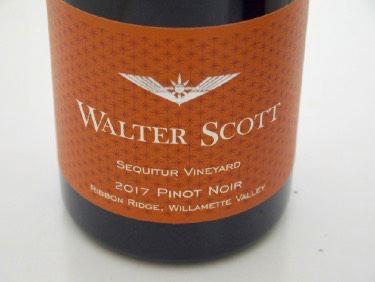 2017 Walter Scott Sequitur Vineyard Ribbon Ridge Willamette Valley Pinot Noir 13.5% alc., $ sold out. · Moderately light garnet color in the glass. Classic Pinot Noir aromatic profile of crushed cherry, rose petal, exotic spice and congenial oak. Delicious cherry core, even hypnotizing. No hard edges in this wine with balanced tannins, invigorating acidity and a captivating finish flush with cherry goodness. It is easy to find superlatives for this beauty. Score: 94
2017 Walter Scott Seven Springs Vineyard Eola-Amity Hills Willamette Valley Pinot Noir 13.5% alc., $65. · Light ruby red color in the glass. Enticing aromas of dusty rose, red cherry and sous-bois. Lighter in style but packs a wallop of flavor. Dark red cherry and cranberry fruits really grab hold of the mid palate and finish juicy and strong. Gracious oak, with modest tannins and a welcome backbone of acidity in a very elegant package. Score: 93
2017 Walter Scott Temperance Hill Eola-Amity Hills Willamette Valley Pinot Noir 13.5% alc., $ sold out. · Light ruby red color in the glass. Really nice aromas of red cherry, cranberry and spice. A cherry bombast in the mouth with supportive oak. The tannins are quite modest and there is a good bolt of acidity. The flavors build in intensity over time in the glass. A tame, less ripe interpretation of this vineyard in this vintage. Score: 93
More Willamette Valley Pinot Noir
2018 Anam Cara Chehalem Mountains Rosé of Pinot Noir 13.2% alc., 110 cases, $25, screw cap. 100% Wädenswil clone from the Nicholas Estate Vineyard. 3-day cold soak, aged in neutral French oak barrels. · Watermelon color in the glass. Aromas of red berry, yellow nectarine and rose petal. Suave in texture and easy to cozy up to, with flavors of strawberry and cranberry. Score: 89
2016 Cameron Clos Electrique Willamette Valley Pinot Noir 13.2% alc., $66. This winery is a member of deep roots coalition and practices sustainable viticulture techniques without irrigating. · A very savory wine with aromas of underbrush, peat moss and piquant herbs with a hint of blackberry. Soft and sleek in the mouth, with a mid weight plus core of purple and black berry fruits and a subtle thread of green bell pepper. Gentle tannins, with a long, fruity finish. More appealing when tasted the following day from a previously opened bottle. A wine for savory character enthusiasts. Score: 91
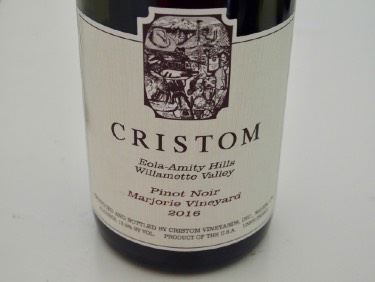 2016 Cristom Marjorie Vineyard Eola-Amity Hills Willamette Valley Pinot Noir 13.5% alc., 300 cases, $69. This is the only vineyard that was kept intact when the property was bought in 1992 and has old time wide row spacing. That said, this is always my favorite vineyarddesignate from Cristom. · Moderate garnet color in the glass. Deep aromas of black cherry, spice and burnt tobacco. Decisive attack of black cherry fruit in a mid weight style with just the right accent of oak spice. Reserved, fine-grain tannins add support and lend a hand to the suave texture. Still a bit reserved but can be enjoyed now and the balance predicts at least ten years of pleasure down the road. There are only three things in life that are certain: death, taxes and the excellence of Cristom Pinot Noir. Score: 96
2016 Drouhin RoseRock Zephirine Eola-Amity Hills Willamette Valley Pinot Noir 14.1% alc., $52. A LIVE certified sustainable vineyard with volcanic soils. A barrel selection by winemaker Veronique Drouhin. The name refers to Zephirine Drouhin variety of climbing rose known for its fragrance and beauty. · Moderately dark garnet color in the glass. The wine is very ripe fruited with aromas and flavors reflecting this. The nose offers scents of boysenberry, plum and vanilla. Plump boysenberry and blackberry fruits are composed in a mid weight plus style and accented with benevolent tannins in the background. Intensely fruity and somewhat sweet with noticeable oak-driven vanilla and cigar notes. Honestly, this wine reminded me of Meomi Pinot Noir. This wine is very highly rated in the wine press so what do I know? Score: 92
2016 Etude Yamhela Vineyard Yamhill-Carlton Willamette Valley Pinot Noir 14.2% alc., pH 3.41, TA 0.65, 673 cases, $65. Dijon 113 and Pommard. The vineyard is Oregon LIVE and Salmon Safe. Aged 14 months in French oak barrels, 25% new. · Moderately dark garnet color in the glass. The nose is dominated by roasted coffee aroma. Mid weight in style with fruit flavors of black cherry and black raspberry and oak-infused flavors of toast and espresso. Nothing notable except good acidity. A slight bit of alcoholic warmth shows up on the modest finish. This wine tastes like a cellar sample from a new, well-toasted oak barrel. No second bottle to sample. Score: 87
2017 Game of Thrones Oregon Pinot Noir 14.4% alc., $17. Game of Thrones wines are the official wines of the HBO series and include an Oregon Pinot Noir and Central Coast Chardonnay released in the spring of · Light ruby red color in the glass. Aromas of red cherry, sandalwood and botanical lead to a lighter styled wine offering darker red berry and stone fruit flavors permeated by an underlying vegetative and smoky note that was unpleasant. Gracious and juicy with a mild tannic grip on the short finish. Not nearly as good as the HBO show. Score: 85
2017 Résonance Willamette Valley Pinot Noir 13.5% alc., $65. Maison Louis Jadot’s first wine project outside of Burgundy, France since the winery’s founding in 1859. Estate grown from the organically farmed Résonance Vineyard that was planted on ungrafted rootstock in 1981. · Moderately light garnet color in the glass. The nose appeals with aromas of red cherry, strawberry, sandalwood and graham. Light to mid weight in style, offering a core of dark red cherry fruit accented with savory herbs and earthiness. Very French in tone, with savory characters dominating fruit notes. The muscular tannins impart an astringent finish. Score: 88
2016 Sequitur Ribbon Ridge Willamette Valley Pinot Noir 13.6% alc., $100. Unfined and unfiltered. Crafted by veteran winemaker Michael Etzel (Beaux Freres). · Moderately dark garnet color in the glass. Aromas of black cherry, sous-bois, cedary oak and a subtle dried herb note. Enchanting charge of well-spiced dark cherry, boysenberry and black raspberry fruits envelope the palate with goodness. A firm backbone of tannins is supportive, an arrow of acidity adds vigor and toasty oak contributes complimentary accents. All the flavors come together in an exalted finish of uncommon length. Score: 94
Recent Tasting of 2016, 2017 & 2018 Willamette Valley Chardonnay
The majority of Willamette Valley Chardonnays fall into the middle ground between the often ripe, fruity and oak-driven California Chardonnays and the more austere and acid-driven French white Burgundies. This is what one would expect as the majority of Willamette Valley Chardonnays are based on Dijon clones (95, 96 and 76) while the overwhelming majority of California Chardonnays are fueled by Wente selections. I still find more California Chardonnays that rock my boat, but I find the Oregon Chardonnays, with their lower alcohol levels and higher natural acidity, to be intriguing and satisfying but not as hedonistic and even too austere in some cases. The Walter Scott Chardonnays, in particular, show reductive winemaking. Reductive is a term used to describe a style of vinification and refers to the relative absence of oxygen during winemaking. This technique is aimed at preserving fresh fruit flavors. Many Chardonnay enthusiasts relish the matchstick or flinty aromas and flavors that accompany reduction as long as it is not overdone when it is combined with some influence of oxygen to maintain the stability of the wine. Oxygen is more desirable in red winemaking since it helps the evolution of color and tannin. Decanting can usually cure Chardonnay wines of reductive notes.
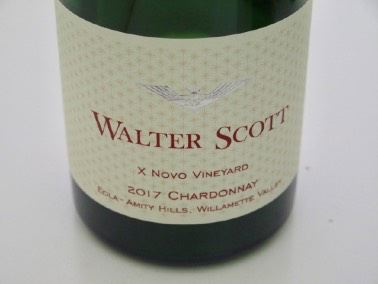 2017 Walter Scott X Novo Vineyard Eola-Amity Hills Willamette Valley Chardonnay 13.0% alc., $65. · Moderately light golden yellow color in the glass. An array of citrus fruit aromas are shadowed with a hint of flint. Rich and full on the palate, with fresh, juicy flavors of lemon, pineapple, tarte tatin and graphite. A sophisticated offering with a pleasing arrow of acidity and a lip smacking finish that seems to go on and on and on. A very special wine. Score: 95
2017 Walter Scott Seven Springs Vineyard Eola-Amity Hills Willamette Valley Chardonnay 13.0% alc., $65. · Moderately light golden yellow color in the glass. Aromas of lemon oil, iron and flint. Graceful and satisfying, offering the essence of lemon complimented by bashful oak. Bright acidity propels the wine to a long, lemony finish that has a hint of graphite. This wine has a regal quality and is as comforting as silk sheets. Score: 94
2017 Big Table Farm The Elusive Queen Willamette Valley Chardonnay 13.1% alc., 102 cases, $85, $195 magnum. Released April 15, 2019. The best Chardonnay from the winery’s 2017 vintage. Unfined and unfiltered. · Light golden yellow color in the glass. Clean aromas of lemon, white peach, apple, white flower blossom, petrichor, beach sand and brioche. Delicious flavors of lemon, pineapple, and pear in a sleek and harmonious style with a saline edge. This beauty urges you to take another sip. Score: 93
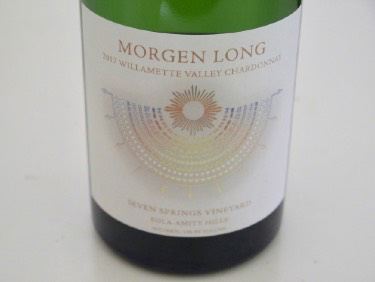 2017 Morgen Long Seven Springs Vineyard Eola-Amity Hills Willamette Valley Chardonnay 13.0% alc., pH 3.26, TA 0.65, RS 1.4 g/L, 67 cases, $60. Dijon clones 95 and 76 planted in Jory and Nekia volcanic soils. After whole cluster pressing, the juice was lightly chaptalized and underwent native fermentation, 100% MLF. Aged 12 months in French oak barrels, 33% new, then transferred to stainless steel for a second winter on the lees. After six months in steel, a light fining with bentonite was followed by bottling unfiltered. · Light golden yellow color in the glass. Harmonious aromas of lemon zest, brioche and caramel. Noticeably viscosity on the palate, with flavors of poached pear, lemon-lime, Golden Delicious apples and a hint of vanilla. Classy juice that has plenty of welcome acidity and length of flavor. Score: 93
2017 Walter Scott Freedom Hill Vineyard Willamette Valley Chardonnay 13.0% alc., $ Sold out. · Moderately light golden yellow color in the glass. Pleasing aromas of white peach and shaved oak. The essence of lemon shines through and is complimented by a grounded earthy component. Tremendous lemony grip on the very long finish. Exquisite balance and very gracious acidity. This wine goes down like mother’s milk. Score: 93
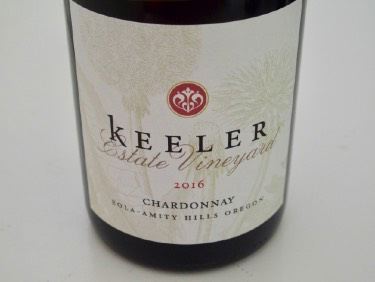 2016 Keeler Estate Vineyard Eola-Amity Hills Willamette Valley Chardonnay 12.5% alc., pH 3.53, TA 0.54, 128 cases, $40. Released October 20, 2018. Dijon clones 96 and 76 (biodynamic). Harvest Brix 20.4º. Aged 14 months on the lees in 75% French oak barrels, 30% new and 25% in stainless steel. · Moderately light golden yellow color in the glass. Delightful aromas of lemon oil, butter, baked yellow apple and pineapple on the grill. Effusive flavors of ripe pear, pineapple, yellow apple and banana. Oily in texture with a ripe fruited finish. Not an acid-driven style, but still has good spirit. Score: 92
2017 Morgen Long Willamette Valley Chardonnay 13.0% alc., pH 3.31, TA 0.63, RS 1.2 g/L, 313 cases, $33. 50% Seven Springs Vineyard Dijon 95 and 76 clones. 20% AlexEli Vineyard 37-year-old clone 108. 10% Loubejac Vineyard, clone 96, 10% Durant Vineyard clones 95 and 76, and 10% Yamhill Vineyard 34-year-old clone 108. Whole cluster pressed. Barrel fermented with some lots chaptalized. Fermentation commenced with native yeasts and full malolactic conversion occurred. After one year in 25% new French oak barrels and 75% neutral French barrels, the wine was blended in stainless steel for a second winter on lees. After five months in steel on the lees, the wine was lightly fined with bentonite before a gentle lenticular filtration. · Light golden yellow color in the glass. Aromas of lemon oil, apple pastry and nutty oak lead to a satisfying wine that is crisp and bright due to hi-strung acidity.. Flavors of lemon-lime, apple, honey and vanilla culminate in a boisterous finish that attracts another sip. Very similar to the Black label bottling but a step above. Score: 92
2017 Walter Scott Justice Vineyard Eola-Amity Hills Willamette Valley Chardonnay 13.0% alc., $55. · Moderately light golden yellow color in the glass. Shy and reductive nose. Very good richness of lemon, pineapple, spice, graphite, flint and dirty oak flavors with a touch of matchstick. Very suave in the mouth, with a trace of tannins and some length to the refreshing finish. Score: 92
2017 Morgen Long Black Label Willamette Valley Chardonnay 12.75% alc., pH 3.27, TA 0.64, RS 0.5 g/L, 172 cases, $25. 25% each Seven Springs, Durant, AlexEli and Yamhill vineyards. Dijon 95, 76, and 34 to 37-year-old clone 108. Native yeast fermentation, full MLF. Aged 6 months in French oak barrels, 10% new, and transferred to stainless steel for 11 months. Lightly fined with bentonite before a gentle lenticular filtration. Black label. · Very light golden yellow color in the glass. Pleasing aromas of baked apple, spice, white flower blossom and toast lead to a bright, fresh and clean-styled wine that is citrus driven and shot through with an arrow of acidity. There is an appealing steely and briny quality to the wine and a cleansing, dry finish. Score: 91
2017 Big Table Farm The Wild Bee Willamette Valley Chardonnay 13.1% alc., 525 cases, $28. Combination of six sites. Unfined and unfiltered. · Moderately light golden yellow color in the glass. Pleasant aromas of white peach and wood shop. Driven by vigorous lemon flavors and a tremendous lemony grip on a very long finish. Exquisite balance with dreamy acidity and a grounded earthy component. Score: 91
2016 LUMOS Wren Vineyard Willamette Valley Chardonnay 12.5% alc., 107 cases, $35. Released October 2018. · Moderate golden yellow color in the glass. A striking aroma of honey is augmented with notes of chalk dust and bruised apple. Flavors of honey, lemon, and golden apple in a discretely rich style with a luscious, silken texture. A bit of oak-driven flavors of nuts, toast and vanilla chime in. Score: 90
2016 Open Claim Vineyards Willamette Valley Chardonnay 13.5% alc., 80 cases, $75. Released May 2019. Dijon clones 95 and 76. Aged 16 months in French oak barrels, 33% new. · Light golden yellow color in the glass. A range of aromas including lemon, apple, warm biscuit and hazelnut cream. Somewhat austere in an acid-driven style, with flavors of lemon, grapefruit, pear and vanilla, finishing upbeat and quenching with a lemon-lime flourish. Score: 90
2018 Chehalem INOX™ Unoaked Willamette Valley Chardonnay 12.9% alc., pH 3.27, TA 0.68, $20, screw cap. Sourced from two estate vineyards. · Very light golden yellow color in the glass. The nose reminds of Pinot Gris with aromas of lychee, white peach and grass. Flavors of lemon-lime, cantaloupe, green apple and a slight grassy note underlain with guarded acidity. I like the wine for its fruitiness, but not as a Chardonnay, for it could easily be mistaken for a Pinot Gris or Sauvignon Blanc. Score: 88
2017 Geødesy Chehalem Mountains Vineyard Chehalem Mountains Willamette Valley Chardonnay 14.1% alc., pH 3.20, TA 0.60, 59 cases, $75. Native yeast fermentation, native MLF, barrel fermented, aged 15 months in French oak barrels, and bottled unfined and unfiltered. · Light golden yellow color in the glass. Very shy nose with faint aromas of wax and yeast. More expressive on the palate, with flavors of lemon, grapefruit, pear and honey. Gentle and refined with vibrant acidity and a lip-smacking finish. Quite agreeable, but I wanted more fruit. Score: 89
2018 Stoller Family Estate Dundee Hills Willamette Valley Chardonnay 12.5% alc., pH 3.18, TA 0.68, $28, screw cap. Unoaked. A mix of all the Chardonnay clones on the estate property. · Light golden yellow color with a little spritz in the glass. Aromas of tropical citrus, spiced pear, white peach, tequila and mulch. Slightly creamy on the palate, with flavors of pear, white peach, lemon and honeydew melon. The finish is zippy with quenching natural acidity. Score: 89
2017 Walter Scott Cuvée Anne Willamette Valley Chardonnay 13.0% alc., $40. · Moderately light golden yellow color in the glass. The nose is quite reductive with aromas of matchstick, Bartlett pear, butter and a hint of toast. Slightly viscous and soothing in the mouth, with a lemon-lime core accented with toasty oak and a bit of flint. The lemon-driven finish has some length. Score: 89
2017 Geødesy Eola Springs Vineyard Eola-Amity Hills Willamette Valley Chardonnay 13.7% alc., pH 3.25, TA 0.60, 47 cases, $75. Whole cluster pressed, barrel fermented with native yeast, native MLF, aged 15 months on the lees, and bottled unfined and unfiltered. · Light golden yellow color in the glass. Reserved aromas of white nectarine, ocean breeze and botanical notes. Rather austere, with demure flavors of lemon, grapefruit and pear with no noticeable oak input. Less acid-driven than the Chehalem Mountains Vineyard bottling. Easygoing, but might put you to sleep. Score: 88
Canned Oregon: “Beyond the Bottle”
The canned wine movement reached general popularity in Oregon when Union Wine Co. started offering its Underwood Pinot Noir and Pinot Gris in 375 cans (the equivalent of half a bottle) in 2014. Underwood’s production took off and by 2018 totaled 244,000 cases. As readers of the PinotFile know, I have an aversion to canned wine. Why would you want to put Pinot Noir, the Queen of Wines, in the lowly flip-top beer can? Cans of wine offer many advantages, including portability, and the lack of need for stems and an opener. Marketing promotion for Canned Oregon wine reads, “Whether exploring the mountain, hanging at the beach or relaxing in the city with friends, Canned Oregon is the perfect complement to every destination.” Cans are easy to transport, lighter than bottles, unbreakable and reduce the environmental imprint. Millennials are particularly attracted to canned wine because of the lack of pretentiousness normally associated with wine. There are a number of disadvantages as well. The consumer cannot see the color of the wine, they cannot swirl it to release aromas and once you open a can, you cannot close it. Wine is reduced to a common beverage much like Coca-Cola or Coors Light. My biggest concern with canned wine is that a typical can contains 375 ml or about 12 ounces, the equivalent of three standard 4-ounce drinks or half a standard 750 ml bottle of wine. Drinkers are used to polishing off a couple of 12-ounce cans of beer (usually 5% ABV) while consuming a couple of cans of wine (usually 13-15% ABV) is equal to swigging an entire bottle of wine and therefore consuming three times as much alcohol. Wine is meant to be sipped and savoured and is not a utility drink like beer or Coke that is often gulped or chugged. Canned Oregon is a lineup of canned wines produced in Oregon by the Stoller Wine Group. First released in the summer of 2018, production as initially 15,000 cases. If you choose to drink wine from a can, I would recommend the Canned Oregon lineup of varietals as the quality is a step above many canned wines in the marketplace. Pinot Gris and Rosé seem to be particularly suitable to this form of packaging. All wines in the lineup are priced at $6.99 (two cans are equivalent to $14 a bottle). The Australians would describe these wines as “smashable,” meaning an easily quaffable, goes-down-easy style. The canned wines reviewed below were poured into proper glassware for tasting and were not sampled directly from the can.
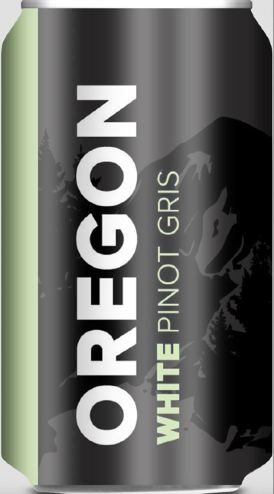
NV Canned Oregon WHITE Pinot Gris 12.5% alc., pH 3.30, TA 0.62. · Nearly clear in color in the glass. Enticing aromas of pear, white melon and pineapple. Juicy flavors of pear, mango and white melon with ideal balance and a dry finish. Consumers will find this wine pleasing and surprisingly high in quality. Score: 90
12.5% alc., pH 3.30, TA 0.63. · Moderate pink color in the glass. Aromas of strawberry, blood orange, rose petal and dried herbs are replicated in the fresh and invigorating flavors. Refreshing, and best served chilled. Score: 89
NV Canned Oregon RED Pinot Noir 13.5% alc., pH 3.60, TA 0.52. · Moderately light garnet color in the glass. Very shy aromas of cherry and sandalwood that do not evolve over time. True to the varietal, with flavors of cherry and cranberry in a light to mid weight style. Minimal tannins make this an easy quaff. Score: 87
NV Canned Oregon WHITE Bubbles 12.5% alc., pH 3.26, TA 0.69. · Light golden yellow color in the glass. Aromas and flavors of pear, white peach, lychee and gooseberry with a good bead and uplifting acidity. Score: 87
NV Canned Oregon PINK Rosé Bubbles 12.5% alc., pH 3.20, TA 0.70. · Moderate pink color in the glass. Lively and upbeat, with aromas of strawberry and watermelon and flavors of red berry and herbs with a slightly sweet finish featuring light red fruits. Score: 88
An update on canned wine. Currently, the TTB requires that canned wine be in 12.6-ounce containers, which is slightly larger than the usual 12-ounce cans typical for beer and soda. The difference is making it difficult for wineries since larger cans are harder to source. The larger can size has to be pre-ordered and it may take 6 to 8 months to obtain them. On another matter, Constellation Brands is partnering with the NFL to introduce its new Crafters Union Pinot Grigio, Red Blend and Rosé wine in a can and is also looking at a single-serve Kim Crawford in a can. Anheuser-Busch InBev has taken a controlling interest in Babe Wine, a canned-wine business. According to Nielsen, more than 20 wine brands sell almost 400 different wines in cans, generating $81 million in annual sales.
Oregon Wine: A Deep-Rooted History
 This book offers a detailed history of winegrowing in Oregon spanning the period from the early 1800s to the modern-day. It is extensively researched and includes a comprehensive bibliography and numerous footnotes. Both color and black and white photos are included in this paperback book. The author dedicates many pages at the beginning unveiling the history of Oregon vineyards and winemaking prior to Prohibition, a period of time that has been largely ignored by wine historians with the limited number of historical accounts filled with considerable misinformation that is not supported by the historical record. Sursa identifies the most frequently cited non-facts and tags them as ‘Myths of Oregon Winemaking’. However, I must point out two “myths” that I feel are unsubstantiated. He describes three purported plantings of Pinot Noir in Oregon including the first by Peter Britt who planted “Frank pinot” in the Rogue Valley in 1887, the second by Adolph and Frederick Reuter who described plantings of “Burgundy” in 1901 in Forest Grove, and the third by August Aufranc who listed Red Burgundy among his plantings. My concern here is that none of these plantings was ever substantiated as Vitus vinifera and more specifically Pinot Noir in the historical record, but instead, reference is made to various paranyms for Pinot Noir used at the time that one could infer as being Pinot Noir grapes. Stursa’s ‘Myth Number Seven’ states that “Peter Britt, not Richard Sommer was the first to grow Pinot Noir in Oregon” and ‘Myth Number Eight’ states that “Frederick Reuter, not Charles Coury or David Lett was the first to grow Pinot Noir in the Willamette Valley.” These two so-called “myths” may well be true, but Stursa offers no proof. John Winthrop Haeger’s excellent book, North American Pinot Noir, sheds no light on this part of Oregon’s wine history nor does Benjamin Lewin’s book, In Search of Pinot Noir, so Scott Stursa’s book is a valuable addition to Oregon’s historical wine archives. Oregon Wine: A Deep-Rooted History, published by American Palate, 2019, 172 pages, $21.99. |